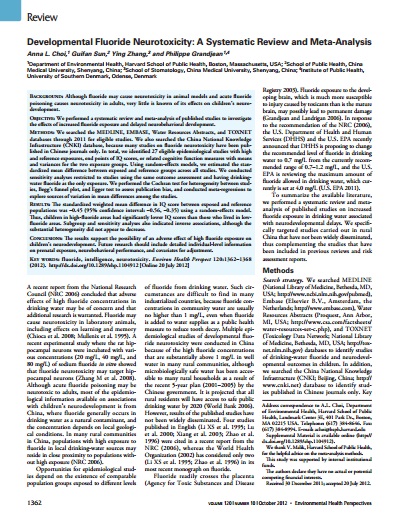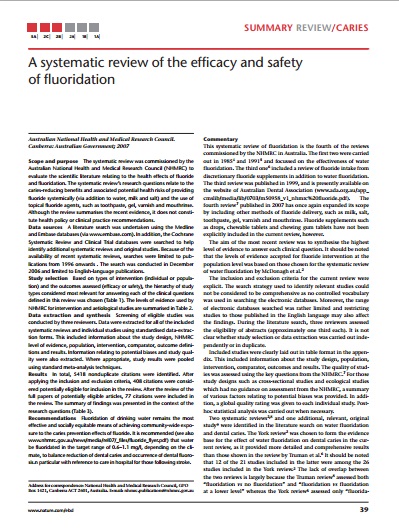| subject | 수돗물 불소화에 대한 찬성 |
|---|---|
| writer | 관리자 |
| date | 18-12-11 09:29 |
| hit | 1,940 |
관련링크본문불소 농도조정반대라는 사이비과학 : 원본 http://mediawatch.kr/news/article.html?no=240151 ※ 본 콘텐츠는 '과학중심의학연구원(http://www.i-sbm.org)'이 제공하는 공익콘텐츠입니다. 이 글은 미국의 대표적인 의학 비평가 중 한 사람인 예일대학교 신경과 임상교수 스티븐 노벨라(Steven Novella)의 수돗물 불소농도조정 반대 운동에 대한 비판 글로, 'Antifluoridation Bad Science'라는 글을 번역한 것입니다. 황의원 과학중심의학연구원 원장이 번역했습니다. 본 글에 인용된 하바드 연구의 관련 기사는 국내에도 <메디컬투데이>가 (“충치 예방하는 '불소' IQ 떨어뜨린다")라는 기사로서 과장되게 소개된 바 있으며, 쿠키뉴스 등을 타고 포탈 뉴스 섹션에까지 널리 퍼지기도 했습니다.
 ▲ 학술지 Environmental Health Perspectives에 실린 논문 Developmental Fluoride Neurotoxicity: A Systematic Review and Meta-Analysis
이 연구가 실제로 발견한 결과에 따르면, 수돗물 불소농도조정과 관련해선 그 어떤 위험도 존재하지 않는다(뭔가 있긴 했지만 그건 안전하다는 결론이 나왔다). 그러나 이 연구는 수돗물 불소농도조정 반대 운동가들에 의해 이상하게 이용됐고, 그들에 의해 이 연구결과는 유언비어 유포의 목적으로 왜곡되어 소개됐다. 불행하게도, 현재 인터넷은 유언비어 유포의 온상인 상황이다.
 ▲ 치과 분야의 대표적인 학술지 중 하나인 Evicence Based Dentistry에 실린 논문 A systematic review of the efficacy and safety of fluoridation
하지만, 지난 50년간의 과학적 연구 결과는, 불소농도조정의 안전성 및 효능만을 계속 재확인하고 있을 뿐이다. 2008년에 실시된, 가장 믿을만한 의학 연구방법론인 ‘체계적 문헌고찰(systematic review)' 논문의 결론은 다음과 같다:
관련 추가적인 배경설명을 원한다면 ‘사이언스인메디슨 연구소(Institute for Science in Medicine)’가 발표한 ‘수돗물 불소농도조정에 대한 정책보고서(policy statement)'를 참조하라. (나를 비롯한 다른 사이언스베이스드메디슨 블로그의 저자들도 사이언스인메디슨 연구소의 회원이다)
원본 https://sciencebasedmedicine.org/antifluoridation-bad-science/ There is a movement in the US to oppose a public health measure that is backed by impressive evidence showing it is safe and effective, as well as highly cost effective. For as long as the government has supported this health measure, there have been those opposed to it, claiming (against the evidence) that it is unsafe, ineffective, and represents a violation of personal freedom and the right to refuse an unwanted medical intervention. I could be talking about vaccines and the anti-vaccine movement, but in this case I am talking about the fluoridation of public water supplies and the antifluoridation movement. This social debate (there isn’t much of a scientific debate) crops up in the news every now and then – mostly prompted by an antifluoridation activist or group making noise, or by a local referendum to block fluoridation in a community. Recently there has been a Harvard study making the rounds of social media, “Developmental Fluoride Neurotoxicity: A Systematic Review and Meta-Analysis.” The actual findings of the study do not show that there is any risk to public water fluoridation (if anything, they show that it is safe), but the study was seized upon by antifluoridation activists and distorted for their propaganda purposes. Unfortunately, the internet is now fertile ground for the spreading of propaganda. The NYS Coalition Opposed to Fluoridation put out a press release distorting the findings of the study. Their press release (“Harvard Study Finds Fluoride Lowers IQ – Published in Federal Gov’t Journal”) was then printed as a science news item by many online news outlets. Reprinting press releases, without any editorial filter, is a cheap and easy way to add news-like content to your website. The Sacramento Bee, for example, published the press release under their “News” tab. Near the top of the page, in small print, they did put a disclaimer (which is better than most sites):
That’s better than nothing, but I wonder how many people reading the press release will notice and read the disclaimer. In my opinion, a news outlet should not reprint press releases sent out from advocacy organizations clearly intended to promote an agenda. They especially should not print them under the banner of “News.” The disclaimer is not adequate. The spreading of this “news item” around Facebook and other social media demonstrates this. Some backgroundBefore I get to the study itself, let me review the basic facts surrounding fluoridation of public water supplies. In the 1940s and 50s in the US there were major studies looking at the role of fluoride in the health of teeth. It was first noticed that too much fluoride, which occurs naturally in many water supplies, can cause a darkening and pitting of the teeth, now called fluorosis. However, smaller amounts of fluoride are necessary for tooth health and can help reduce tooth decay. Fluoride can help remineralize the enamel of teeth, to reduce or even reverse destruction by acid-producing bacteria. The turning point in terms of evidence came with the publication of a study in 1950 – Dr. H. Trendley Dean, head of the Dental Hygiene Unit at the National Institute of Health published the results of a study in Grand Rapids, Michigan in which fluoride was added to the drinking water of one community and not another. The study revealed a 50% decrease in dental cavities in the fluoridated community compared to the control. This and other evidence led to the recommendation to adjust the fluoride levels of local water supplies to about 1 mg/L (or 1 part per million, ppm). Some communities have natural levels of fluoride in the water at higher levels, and these are often reduced. The decision on whether and how to adjust fluoride is made at the municipal and local governmental level – not the Federal level. Therefore, some communities add fluoride while others do not. Immediately after the recommendation was made and some communities started adding fluoride, the antifluoridation movement started. The primary motivation seems to be objecting to the imposition on personal freedom, seeing fluoridation as involuntary medication. Groups that oppose fluoridation, however, are typically not content to make the freedom argument, but rather also distort the evidence to argue that fluoridation is not safe or effective, despite the actual evidence. At the fringe there are also those who believe that the fluoridation of water is part of a dark government conspiracy to make us all into mindless slaves. (These conspiracy theories were famously lampooned in the brilliant movie Dr. Stranglove, when the character General Jack Ripper talks about the violation of his “precious bodily fluids.”) The last 50 years of scientific research has only confirmed the safety and efficacy of fluoridation. A 2008 systematic review of this research concluded:
For further background see the policy statement on fluoridation by the Institute for Science in Medicine (of which I and other SBM authors are members). The Harvard studyThe Harvard study is actually not a new study, but a review of prior research. Further, the studies reviewed did not involve water fluoridation programs. The review concludes:
“The possibility” of an effect justifying future research is not the same as concluding that there is an effect. But the problems with the way this review is being presented go far deeper. The implication being implied by anti-fluoride groups is that the fluoridation program in the US and elsewhere is putting children’s IQs at risk. This data, however, cannot be used to support that conclusion. First it should be noted that almost all of the studies reviewed were conducted in China (one was conducted in Iran) – not in the US. China had a limited fluoridation program for a time, and has had no fluoridation of drinking water since 2002. So why, then, are most of the studies from China? There are many rural areas of China that have naturally high levels of fluoride in the well water. The studies were largely looking at this exposure. Two studies looked at fluoride exposure from inhaling smoke from coal burning. So the question is – how do these levels of exposure relate to the amount of fluoride being added to water in the US (because toxicity is always all about dose)? There was a lot of variability across the studies, but generally the high fluoride groups were in the 2-10 mg/L range, while the reference low fluoride groups were in the 0.5-1.0 mg/L range (not including the coal burning studies, which had much higher fluoride levels). The recommended fluoride level for fluoridated drinking water is 0.5-1.0 mg/L (similar in most countries – Australia, for example, uses 0.6-1.1 mg/L). The EPA set the upper safe limit at 4.0, with a secondary (voluntary) recommendation of 2.0. Areas with high natural fluoride actually have some of the fluoride removed from the drinking water. In other words – fluoridated water in the US has the same level of fluoride as the control or low fluoride groups in the China studies reviewed in the recent article, and the negative association with IQ was only found where fluoride levels were much higher – generally above EPA limits. Also – these studies were mostly epidemiological or ecological – they were not experimental studies (like the Grand Rapids study) in which variables were controlled in any way. It is possible, and even likely, that the high levels of fluoride exposure from natural or industrial sources (not deliberate fluoridation) also correlate with exposure to other contaminants, such as arsenic. Conclusion: Your drinking water is still safeThere are many weaknesses to the epidemiological studies reviewed in the recent article – high heterogeneity, poor controlling for other variables, no indication of blinding of IQ assessments, and many others. But even taken at face value they do not indicate any association between lower IQ and the fluoride levels added to drinking water in the US. In fact, those levels of fluoride were used as the controls in these studies showing higher IQ. (There was a lot of variance of the effect size, but the net effect size on IQ in the meta-analysis was -0.45 standard deviations). Therefore, if anything, this review adds to the body of evidence for the safety of fluoridation. This fact has not stopped anti-fluoridation groups from exploiting the review for their own propaganda purposes. Otherwise respectable news outlets are unwittingly collaborating in this anti-scientific propaganda campaign by lazily reprinting these press releases in their news sections – without any editorial filter. The “fluoride wars” are likely to continue as long there is a fluoridation program. This is evidence that there is no public safety measure that is so effective, safe, and cost effective that there will not be those who vigorously oppose its implementation.
|
|
댓글목록
등록된 댓글이 없습니다.